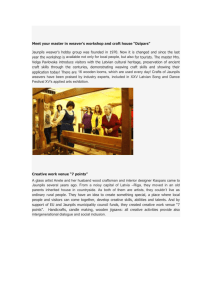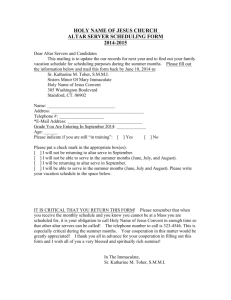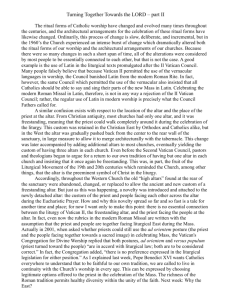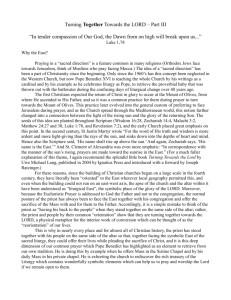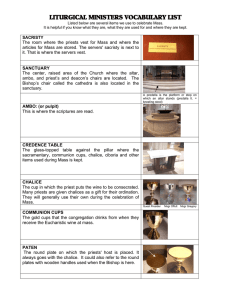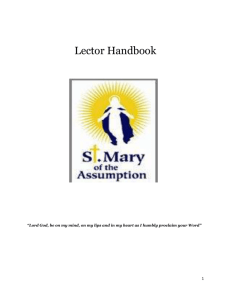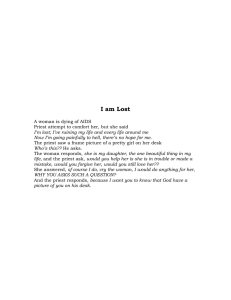STANDARD PROCEDURES FOR LECTORS
advertisement
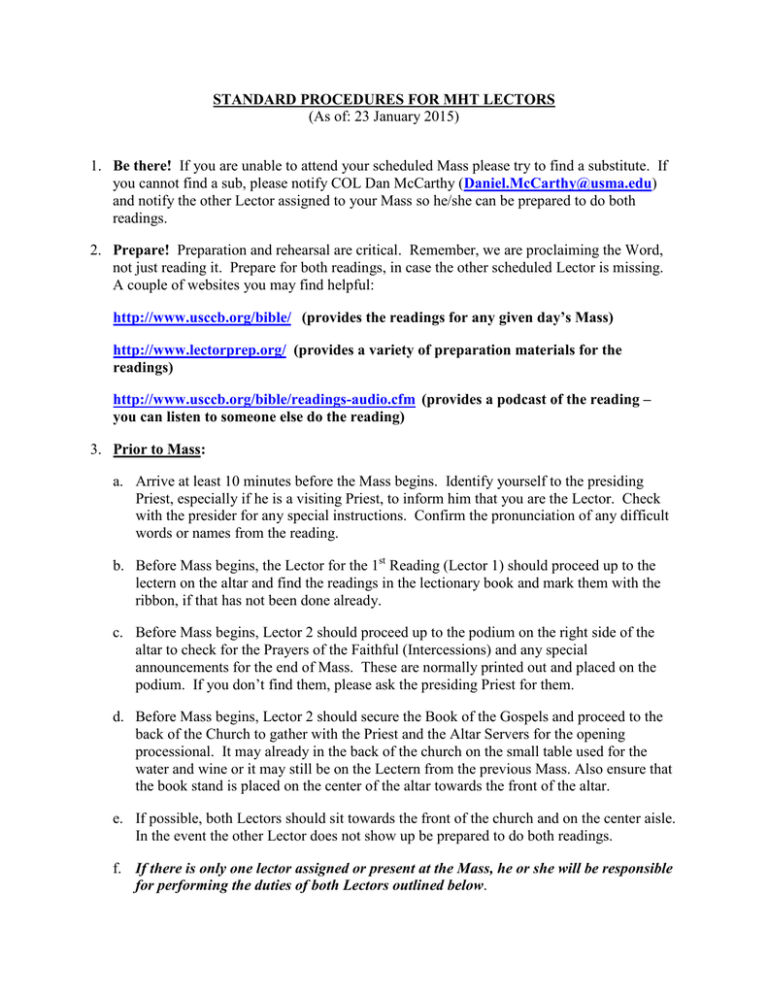
STANDARD PROCEDURES FOR MHT LECTORS (As of: 23 January 2015) 1. Be there! If you are unable to attend your scheduled Mass please try to find a substitute. If you cannot find a sub, please notify COL Dan McCarthy (Daniel.McCarthy@usma.edu) and notify the other Lector assigned to your Mass so he/she can be prepared to do both readings. 2. Prepare! Preparation and rehearsal are critical. Remember, we are proclaiming the Word, not just reading it. Prepare for both readings, in case the other scheduled Lector is missing. A couple of websites you may find helpful: http://www.usccb.org/bible/ (provides the readings for any given day’s Mass) http://www.lectorprep.org/ (provides a variety of preparation materials for the readings) http://www.usccb.org/bible/readings-audio.cfm (provides a podcast of the reading – you can listen to someone else do the reading) 3. Prior to Mass: a. Arrive at least 10 minutes before the Mass begins. Identify yourself to the presiding Priest, especially if he is a visiting Priest, to inform him that you are the Lector. Check with the presider for any special instructions. Confirm the pronunciation of any difficult words or names from the reading. b. Before Mass begins, the Lector for the 1st Reading (Lector 1) should proceed up to the lectern on the altar and find the readings in the lectionary book and mark them with the ribbon, if that has not been done already. c. Before Mass begins, Lector 2 should proceed up to the podium on the right side of the altar to check for the Prayers of the Faithful (Intercessions) and any special announcements for the end of Mass. These are normally printed out and placed on the podium. If you don’t find them, please ask the presiding Priest for them. d. Before Mass begins, Lector 2 should secure the Book of the Gospels and proceed to the back of the Church to gather with the Priest and the Altar Servers for the opening processional. It may already in the back of the church on the small table used for the water and wine or it may still be on the Lectern from the previous Mass. Also ensure that the book stand is placed on the center of the altar towards the front of the altar. e. If possible, both Lectors should sit towards the front of the church and on the center aisle. In the event the other Lector does not show up be prepared to do both readings. f. If there is only one lector assigned or present at the Mass, he or she will be responsible for performing the duties of both Lectors outlined below. 4. Opening Announcement (1st Lector): a. A few minutes prior to the beginning of Mass, the 1st Lector should proceed up to the podium on the right side of the altar and prepare to make the Opening Announcement. The Opening Announcement should be printed in the binder on the podium and should include the page number and title of the opening song. If not, look at the wooden sign next to the podium which lists the song numbers for the Mass and then craft the opening announcement as follows: “Good morning. Welcome to Most Holy Trinity. The entrance song can be found in the “Breaking Bread” missal (sometimes from the red “Gather” hymnal) at number 123, “Come All Ye Faithful.” Please rise and join our celebration by singing number 123.” FYI: Song numbers listed on the right side of the music board come from the “Breaking Bread” missal and those listed on the left side come from the red “Gather” hymnal. The number listed in the middle is the page in the missal for the Responsorial Psalm. b. The Lector should watch for a signal from the presiding Priest at the back of the church to begin Mass. Upon signal from the presiding Priest, the Lector should welcome the congregation and read the Opening Announcement. c. In the event there isn’t a second Lector, proceed immediately to the back of the Church and process in with the Book of the Gospels as outlined below. 5. Processing in with the Book of the Gospels (2nd Lector): a. The 2nd Lector will carry in the Book of the Gospels as part of the Opening Processional. You should situate yourself behind the Altar Servers and in front of the Priest during the processional. b. You should carry the Book of the Gospels with two hands out in front of you at a comfortable height (chest height or higher). Carry the book with the front cover (the ornate side) facing away from you. c. The procession should proceed directly up onto the altar where it will pause for the Priest to bow. You should not bow while holding the Book of the Gospels. After the Priest bows, the altar servers should proceed to put the Cross and the candles in their proper places on the altar. At this time, you should place the Book of the Gospels in the book stand on the front of the main altar with the front cover (again the ornate side) facing the congregation. You’ll need to turn the book around in order to do this. d. Place the book into the stand from in front of the altar. Do not go around the back side of the altar. You may want to check before Mass that there is enough room to reach the altar from the front as sometimes there are flowers in front of the altar that may make it difficult to reach the book stand on the altar. e. Once you have place the Book of the Gospels on the altar table, step down from the altar and return to your seat, pausing to briefly bow towards the altar. 6. First Reading (1st Lector): a. After the Priest has read the opening prayer (this is the prayer after the singing of the Gloria) and the congregation begins to sit down, the 1st Lector proceeds up the center aisle towards the lectern, pausing to briefly bow before the altar. b. Once at the lectern, you might have to wait for the children to be dismissed for Children’s Liturgy. (FYI: This doesn’t happen at every Mass.) If there is Children’s Liturgy, the children exit to the back of the church accompanied by music. Wait for the music to stop before starting the First Reading. c. Announce “A Reading from …” then pause briefly before beginning the actual reading. d. After you have completed the reading, pause momentarily, look at the congregation and announce “The Word of the Lord.” Do NOT pick up the lectionary as you do this. e. As a courtesy, turn to the page in the lectionary where the second reading begins. f. Step down from the lectern and return to your seat, bowing briefly towards the altar. It is not necessary to wait for the choir to begin the Responsorial Psalm before leaving the lectern (Often they are waiting for you to leave before starting the psalm). 7. Second Reading (2nd Lector): a. Upon the conclusion of the Responsorial Psalm, the 2nd Lector stands and proceeds to the lectern, pausing to briefly bow before the altar. b. Once at the lectern, after any commentary on the reading by the presiding Priest, announce “A Reading from…” Pause briefly before beginning the actual reading. c. After you have completed the reading, pause momentarily, look at the congregation and announce “The Word of the Lord.” Do NOT pick up the lectionary as you do this. d. As a courtesy, please close the lectionary and place it on the shelf under the lectern so the Priest has room for the Book of the Gospels on the lectern. If the shelf is full, place the lectionary on the small altar just next to the lectern. e. Step down from the lectern and return to your seat, bowing briefly towards the altar. 8. Prayers of the Faithful (2nd Lector): a. At the beginning of the last paragraph of the Nicene Creed (“I believe in one holy, catholic, and apostolic Church…”) proceed up to the podium on the right side of the altar. b. At the conclusion of the Priest’s introduction to the Prayers of the Faithful, read the intercessions. After each intercession, announce “We pray to Lord.” c. After the last intercession, wait until the Priest gives his final intercession (or prayer) and then announce the Offertory song and invite people to bring up food for the food basket. “The offertory song can be found in the Breaking Bread missal at number 123, “Here I am Lord.“ Please join us in singing number 123. (Pause) At this time, if you have gifts for the food basket you can bring them to the front.” d. After announcing the offertory song, head back to your seat bowing briefly towards the altar. 9. Closing Announcements (2nd Lector): a. Check with the Priest before Mass. Sometimes they like to do the announcements. b. After Communion is finished, while the Priest is cleaning the vessels and clearing the altar, proceed up to the podium on the right side of the altar and prepare to read the Closing Announcements. c. After the Priest has said the Prayer after Communion (Closing Prayer), read the announcements that are on the lectern. Some priests prefer to have the announcements read before the Closing Prayer. Just watch the Priest to see if he signals you to read the announcements early. d. When finished with the announcements, immediately head back to your seat, bowing briefly towards the altar. You shouldn’t wait until after the final blessing/dismissal to return to your seat. 10. Proclaiming the Word: 1. Be prepared. Spend time during the week leading up to Mass looking over the reading you have been assigned. Use the available web sites to get an understanding of the reading and the historical context. This will help you proclaim the word as it was intended. 2. Break the reading down and decide where you may need to provide extra emphasis, perhaps an extended pause, to allow the congregation to reflect on the reading. 3. Start strong and confidently. Memorize the introduction to the reading (e.g. “A reading from the Letter of Saint Paul to the Philippians.”) Memorize the first line of the reading so that you can begin the reading maintaining good eye contact with the congregation. 4. Read SLOWLY. People have a tendency to read too fast. Deliberately pause at natural breaks in the reading to allow the congregation time to absorb the reading. 5. Your goal should be to proclaim the reading in such a way as to have the congregation listen to you, rather than read along in their missals. 6. In the end, as Lectors we are not intended to be actors. Do not be overly dramatic in proclaiming the reading as that can become distracting to the congregation. Notes: 1. There are three cycles to the lectionary (A, B & C). These cycles are rotated each liturgical year. There are some special times when the cycles are merged into only one cycle, for example during Lent (in conjunction with RCIA in particular) and the Triduum (Thursday, Friday and Saturday of Holy Week). Be prepared to receive special instructions for shared readings or additional readings during Christmas, Lent and Easter. 2. There are times when the readings are offered in a short and a long version. Check with the presiding Priest before Mass begins to see if he wants you to use the short or long version of any reading. Also check with the Priest if you have questions on pronunciation or any other difficulties with the readings before Mass. Please call or email COL Dan McCarthy, MHT Lector Coordinator, with questions or concerns: Daniel.McCarthy@usma.edu Home: (845) 859-4200 Work: (845) 938-4893 Cell: (845) 857-8203 Thanks for your willingness to serve our parish in this most important ministry!
